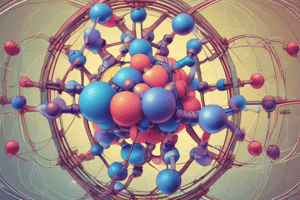Podcast
Questions and Answers
Which of the following correctly describes the arrangement of particles in a liquid according to the kinetic molecular model?
Which of the following correctly describes the arrangement of particles in a liquid according to the kinetic molecular model?
- Particles are far apart and move independently of each other.
- Particles are fixed in a rigid, crystalline structure.
- Particles are in a constant state of vibration but cannot move past each other.
- Particles are close together and have high freedom of movement. (correct)
Which of the following properties of solids is best explained by the close packing of particles in a solid according to the kinetic molecular model?
Which of the following properties of solids is best explained by the close packing of particles in a solid according to the kinetic molecular model?
- Fluidity
- High compressibility
- High density (correct)
- Low melting point
According to the kinetic molecular model, what is the primary reason for the incompressibility of liquids?
According to the kinetic molecular model, what is the primary reason for the incompressibility of liquids?
- The constant motion of particles within the liquid.
- The close packing of particles in a liquid state.
- The absence of significant empty space between liquid particles. (correct)
- The strong intermolecular forces holding the liquid particles together.
Which of the following statements best describes the diffusion of particles in a liquid according to the kinetic molecular model?
Which of the following statements best describes the diffusion of particles in a liquid according to the kinetic molecular model?
According to the kinetic molecular model, which of the following factors primarily influences the viscosity of a liquid?
According to the kinetic molecular model, which of the following factors primarily influences the viscosity of a liquid?
Flashcards
Kinetic Molecular Model
Kinetic Molecular Model
A theory that explains the behavior of matter based on the motion of its particles.
Properties of Liquids
Properties of Liquids
Characteristics of liquids, including fluidity, viscosity, and surface tension, influenced by particle interaction.
Properties of Solids
Properties of Solids
Characteristics of solids, such as rigidity and fixed shape, due to closely packed particles.
Fluidity
Fluidity
Signup and view all the flashcards
Viscosity
Viscosity
Signup and view all the flashcards
Study Notes
REMEMBERING Level Multiple Choice Questions
-
Question 1 Which state of matter exhibits a definite shape and volume?
-
a) Gas
-
b) Liquid
-
c) Solid
-
d) Plasma
-
Question 2 What does the kinetic molecular theory state about the movement of particles in a liquid?
-
a) Particles are fixed in position.
-
b) Particles are stationary.
-
c) Particles are in constant, random motion.
-
d) Particles move in a predictable, orderly fashion.
-
Question 3 How do particles in a solid arrange themselves compared to those in a liquid?
-
a) Randomly, widely spaced.
-
b) Randomly, closely packed.
-
c) In a regular, geometric pattern, closely packed.
-
d) In a regular, geometric pattern but widely spaced apart
-
Question 4 Which property of liquids is explained by the fact that particles of liquid can move around each other but are still attracted to each other?
-
a) Definite volume
-
b) Definite shape
-
c) Fluidity
-
d) Compressibility
-
Question 5 How do the particles in a gas compare to those in a liquid in terms of their average kinetic energy?
-
a) Gas particles have higher kinetic energy than liquid particles.
-
b) Gas particles have lower kinetic energy than liquid particles.
-
c) Gas and liquid particles have the same average kinetic energy.
-
d) Average kinetic energy depends on the container type.
Study Notes on the Kinetic Molecular Model and States of Matter
- The kinetic molecular theory explains the behavior of matter in terms of the motion of its constituent particles.
- It describes the properties of solids, liquids, and gases in terms of the particles’ kinetic energy, attraction between particles, and their arrangement.
Key Concepts: Solids
- Particles: Closely packed in a regular, repeating pattern.
- Motion: Vibrate around fixed positions; minimal movement.
- Attraction: Strong intermolecular forces.
- Volume: Definite volume.
- Shape: Definite shape.
Key Concepts: Liquids
- Particles: Closely packed but not arranged in a regular pattern—random arrangement.
- Motion: Particles can move past each other.
- Attraction: Moderate intermolecular forces.
- Volume: Definite volume.
- Shape: Indefinite shape—takes the shape of its container.
Key Concepts: Gases
- Particles: Widely spaced and randomly arranged
- Motion: Particles are in constant, rapid, random motion in all directions.
- Attraction: Negligible intermolecular forces.
- Volume: Indefinite volume.
- Shape: Indefinite shape—takes the shape and volume of its container.
Explaining Properties using the Kinetic Molecular Model
- The kinetic energy of the particles and the forces between them determine the substance's physical state (solid, liquid, gas).
- The closer the particles are, the stronger the intermolecular forces, which explain why liquids and solids generally have higher densities than gases.
- The faster the particles move, the higher their kinetic energy, and the more freedom they have to move, leading to a gas's characteristic properties.
- In liquids, the particles have enough kinetic energy to move past one another but are still held together by intermolecular attractive forces, leading to free-flowing properties but also maintain a definite volume.
- In solids, the particles have low kinetic energy, held together by strong intermolecular forces that cause them to stay in a fixed position, leading to shape and volume.
Key Differences Summary
| Property | Solid | Liquid | Gas |
|---|---|---|---|
| Particle Arrangement | Regular, repeating pattern | Random, close packing | Random, widely spaced |
| Particle Motion | Vibrate in fixed positions | Move past each other | Constant, rapid, random motion |
| Intermolecular Forces | Strong | Moderate | Weak |
| Volume | Definite | Definite | Indefinite |
| Shape | Definite | Indefinite | Indefinite |
Studying That Suits You
Use AI to generate personalized quizzes and flashcards to suit your learning preferences.




